The AMD Radeon RX Vega 64 & RX Vega 56 Review: Vega Burning Bright
by Ryan Smith & Nate Oh on August 14, 2017 9:00 AM ESTPower, Temperature, & Noise
Moving on from performance metrics, we’ll touch upon power, temperature, and noise. This is also normally where we’d discuss voltages, but as Vega is a new chip on a new architecture, nothing seems to read Vega 64 and 56 correctly.
In terms of average game clockspeeds, neither card maintains its boost specification at 100% with prolonged usage. Vega 64 tends to stay closer to its boost clocks, which is in line with its additional power overhead and higher temperature target over Vega 56.
| Radeon RX Vega Average Clockspeeds | ||
| Radeon RX Vega 64 Air | Radeon RX Vega 56 | |
| Boost Clocks |
1546MHz
|
1471MHz
|
| Max Boost (DPM7) |
1630MHz
|
1590MHz
|
| Battlefield 1 |
1512MHz
|
1337MHz
|
| Ashes: Escalation |
1542MHz
|
1354MHz
|
| DOOM |
1479MHz
|
1334MHz
|
| Ghost Recon: Wildlands |
1547MHz
|
1388MHz
|
| Dawn of War III |
1526MHz
|
1335MHz
|
| Deus Ex: Mankind Divided |
1498MHz
|
1348MHz
|
| GTA V |
1557MHz
|
1404MHz
|
| F1 2016 |
1526MHz
|
1394MHz
|
| FurMark |
1230MHz
HBM2: 868MHz |
1099MHz
HBM2: 773MHz |
With games, the HBM2 clocks ramp up and stay at their highest clock state. Expectedly, the strains of FurMark cause the cards to oscillate memory clocks: between 945MHz and 800MHZ for Vega 64, and between 800MHz and 700MHz for Vega 56. On that note, HBM2 comes with an idle power state (167MHz), an improvement on Fiji's HBM1 single power state. Unfortunately, the direct power savings are a little obscured since, as we will soon see, Vega 10 is a particularly power hungry chip.
As mentioned earlier, we used the default out-of-the-box configuration for power: Balanced, with the corresponding 220W GPU power limit. And under load, Vega needs power badly.
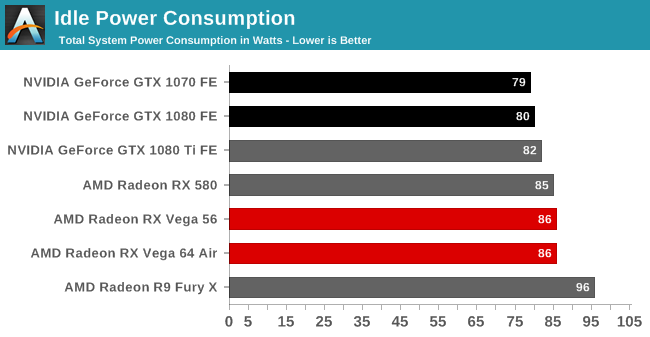
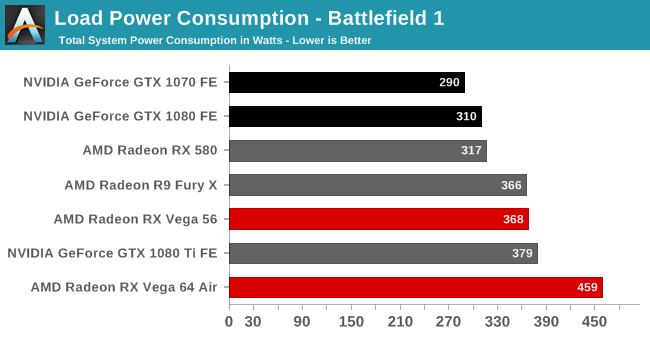
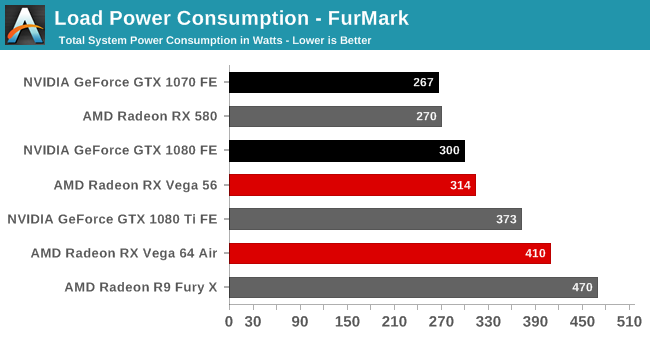
The performance of both Vega cards comes at a significant power cost. For the RX 500 series, we mused that load consumption is where AMD paid the piper. Here, the piper has taken AMD to the cleaners. In Battlefield 1, Vega 64 consumes 150W more system-wide power than the GTX 1080, its direct competitor. To be clear, additional power draw is expected, since Vega 64 is larger in both shader count (4096 vs. 2560) and die size (486mm2 vs. 314mm2) to the GTX 1080. But in that sense, when compared with the 1080 Ti, powered by the 471mm2 GP102, Vega 64 still consumes more power.
As for Vega 64's cut-down sibling, Vega 56's lower temperature target, lower clocks, and lower board power make its consumption look much more reasonable, although it is still well above the 1070.
In any case, the cooling solutions are able to do the job without severe effects on temperature and noise. As far as blowers go, RX Vega 64 and 56 are comparable to the 1080 Ti FE blower.
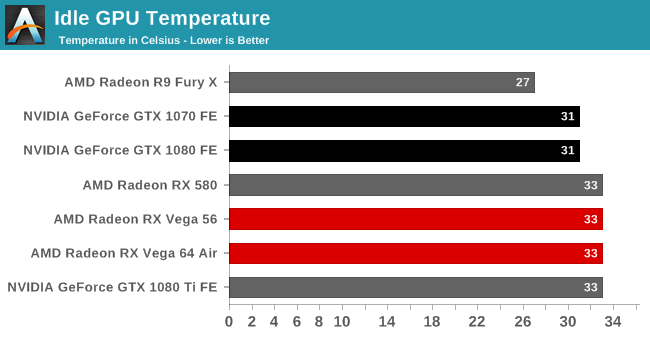
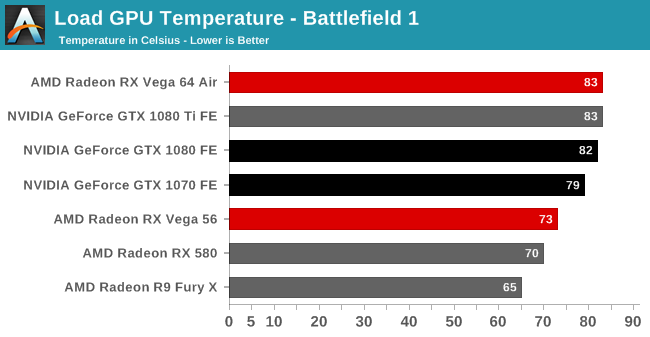

Not Graphed: Temperature of the actual Vega (Star): 9329C
Noise-testing equipment and methodology differ from past results, with a more sensitive noise meter and closer distance to the graphics card. Readings were also taken with an open case. As such, the noise levels may appear higher than expected.

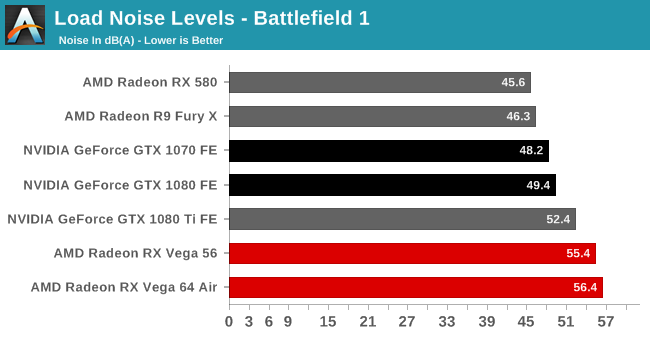
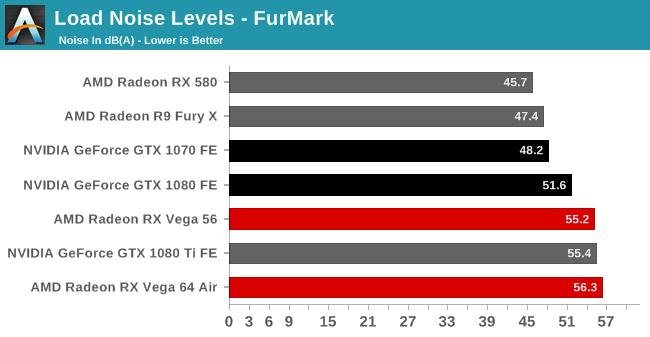










213 Comments
View All Comments
BrokenCrayons - Monday, August 14, 2017 - link
The hypothetical APU that contains Zen, Polaris/Vega, and HBM2 would be interesting if AMD can keep the power and heat down. Outside of the many cores Threadripper, Zen doesn't do badly on power versus performance so something like 4-6 CPU cores plus a downclocked and smaller GPU would be good for the industry if the package's TDP ranged from 25-95W for mobile and desktop variants.By itself though, Vega is an inelegant and belated response to the 1080. It shares enough in common with Fiji that it strikes me as an inexpensive (to engineer) stopgap that tweaks GCN just enough to keep it going for one more generation. I'm hopeful that AMD will have a better, more efficient design for their next generation GPU. The good news is that with the latest product announcements, AMD will likely avoid bankruptcy and get a bit healthier looking in the near term. Things were looking pretty bad for them until Ryzen's announcement, but we'll need to see a few more quarters of financials that ideally show a profit in order to be certain the company can hang in there. I'm personally willing to go out on a limb and say AMD will be out of the red in Q1 of FY18 even without tweaking the books on a non-GAAP basis. Hopefully, they'll have enough to pay down liabilities and invested in the R&D necessary to stay competitive. With process node shrinks coming far less often these days, there's an several years' long opening for them right now.
TheinsanegamerN - Monday, August 14, 2017 - link
" It shares enough in common with Fiji that it strikes me as an inexpensive (to engineer) stopgap that tweaks GCN just enough to keep it going for one more generation. "We thought the same thing about polaris. I think the reality is that AMD cannot afford to do a full up arch, and can only continue to tweak GCN in an attempt to stay relevant.
They still have not done a Maxwell-Esq redesign of their GPUs streamlining them for consumer use. They continue to put tons of compute in their chips which is great, but it restricts clock rates and pushes power usage sky high.
mapesdhs - Monday, August 14, 2017 - link
I wonder if AMD decided it made more sense to get back into the CPU game first, then focus later on GPUs once the revenue stream was more healthy.Manch - Tuesday, August 15, 2017 - link
Just like there CPU's it's a jack of all trades design. Cheaper R&D to use one chip for many but you got to live with the trade offs.The power requirement doesn't bother me. Maybe after the third party customs coolers, I'll buy one if it's the better deal. I have a ventilated comm closet. All my equipment stays in there, including my PCs. I have outlets on the wall to plug everything else into. Nice and quiet regardless of what I run.
Sttm - Monday, August 14, 2017 - link
That Battlefield 1 Power Consumption with Air, is that actually correct? 459 watts.... WTF AMD.Aldaris - Monday, August 14, 2017 - link
Buggy driver? Something is totally out of whack there.Ryan Smith - Monday, August 14, 2017 - link
Yes, that is correct.I also ran Crysis 3 on the 2016 GPU testbed. That ended up being 464W at the wall.
haukionkannel - Monday, August 14, 2017 - link
Much better than I expected!Nice to see competition Also in GPU highend. I was expecting the Vega to suffer deeply in DX11, but it is actuallu doing very nice in those titles... I am really surpriced!
Leyawiin - Monday, August 14, 2017 - link
A day late and a dollar short (and a power pig at that). Shame. I was hoping for a repeat of Ryzen's success, but they'll sell every one they make to miners so I guess its still a win.Targon - Monday, August 14, 2017 - link
I would love to see a proper comparison between an AMD Ryzen 7 and an Intel i7-7700k at this point with Vega to see how they compare, rather than testing only on an Intel based system, since the 299X is still somewhat new. All of the Ryzen launch reviews were done on a new platform, and the AMD 370X is mature enough where reviews will be done with a lot more information. Vega is a bit of a question mark in terms of how well it does when you compare between the two platforms. Even how well drivers should have matured in how well the 370X chipset deals with the Geforce 1080 is worth looking at in my opinion.I've had the thought, without resources, that NVIDIA drivers may not do as well on an AMD based machine compared to an Intel based machine, simply because of driver issues, but without a reasonably high end video card from AMD, there has been no good way to do a comparison to see if some of the game performance differences between processors could have been caused by NVIDIA drivers as well.